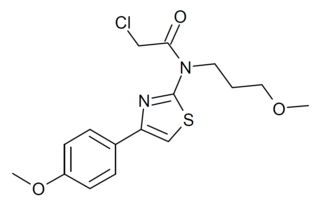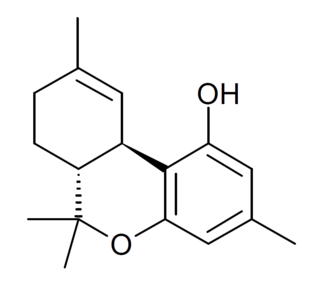Transient receptor potential channels are a group of ion channels located mostly on the plasma membrane of numerous animal cell types. Most of these are grouped into two broad groups: Group 1 includes TRPC, TRPV, TRPVL, TRPM, TRPS, TRPN, and TRPA. Group 2 consists of TRPP and TRPML. Other less-well categorized TRP channels exist, including yeast channels and a number of Group 1 and Group 2 channels present in non-animals. Many of these channels mediate a variety of sensations such as pain, temperature, different kinds of tastes, pressure, and vision. In the body, some TRP channels are thought to behave like microscopic thermometers and used in animals to sense hot or cold. Some TRP channels are activated by molecules found in spices like garlic (allicin), chili pepper (capsaicin), wasabi ; others are activated by menthol, camphor, peppermint, and cooling agents; yet others are activated by molecules found in cannabis or stevia. Some act as sensors of osmotic pressure, volume, stretch, and vibration. Most of the channels are activated or inhibited by signaling lipids and contribute to a family of lipid-gated ion channels.
Ryanodine receptors form a class of intracellular calcium channels in various forms of excitable animal tissue like muscles and neurons. There are three major isoforms of the ryanodine receptor, which are found in different tissues and participate in different signaling pathways involving calcium release from intracellular organelles. The RYR2 ryanodine receptor isoform is the major cellular mediator of calcium-induced calcium release (CICR) in animal cells.

The transient receptor potential cation channel subfamily V member 1 (TrpV1), also known as the capsaicin receptor and the vanilloid receptor 1, is a protein that, in humans, is encoded by the TRPV1 gene. It was the first isolated member of the transient receptor potential vanilloid receptor proteins that in turn are a sub-family of the transient receptor potential protein group. This protein is a member of the TRPV group of transient receptor potential family of ion channels.
TRPC is a family of transient receptor potential cation channels in animals.

Chemokine receptor CXCR3 is a Gαi protein-coupled receptor in the CXC chemokine receptor family. Other names for CXCR3 are G protein-coupled receptor 9 (GPR9) and CD183. There are three isoforms of CXCR3 in humans: CXCR3-A, CXCR3-B and chemokine receptor 3-alternative (CXCR3-alt). CXCR3-A binds to the CXC chemokines CXCL9 (MIG), CXCL10 (IP-10), and CXCL11 (I-TAC) whereas CXCR3-B can also bind to CXCL4 in addition to CXCL9, CXCL10, and CXCL11.

Capsazepine is a synthetic antagonist of capsaicin. It is used as a biochemical tool in the study of TRPV ion channels.

TRPA is a family of transient receptor potential ion channels. The TRPA family is made up of 7 subfamilies: TRPA1, TRPA- or TRPA1-like, TRPA5, painless, pyrexia, waterwitch, and HsTRPA. TRPA1 is the only subfamily widely expressed across animals, while the other subfamilies are largely absent in deuterostomes.

Short transient receptor potential channel 3 (TrpC3) also known as transient receptor protein 3 (TRP-3) is a protein that in humans is encoded by the TRPC3 gene. The TRPC3/6/7 subfamily are implicated in the regulation of vascular tone, cell growth, proliferation and pathological hypertrophy. These are diacylgylcerol-sensitive cation channels known regulate intracellular calcium via activation of the phospholipase C (PLC) pathway and/or by sensing Ca2+ store depletion. Together, their role in calcium homeostasis has made them potential therapeutic targets for a variety of central and peripheral pathologies.

Transient receptor potential cation channel, subfamily A, member 1, also known as transient receptor potential ankyrin 1, TRPA1, or The Wasabi Receptor, is a protein that in humans is encoded by the TRPA1 gene.

Protein kinase C epsilon type (PKCε) is an enzyme that in humans is encoded by the PRKCE gene. PKCε is an isoform of the large PKC family of protein kinases that play many roles in different tissues. In cardiac muscle cells, PKCε regulates muscle contraction through its actions at sarcomeric proteins, and PKCε modulates cardiac cell metabolism through its actions at mitochondria. PKCε is clinically significant in that it is a central player in cardioprotection against ischemic injury and in the development of cardiac hypertrophy.

Prostaglandin E2 receptor 4 (EP4) is a prostaglandin receptor for prostaglandin E2 (PGE2) encoded by the PTGER4 gene in humans; it is one of four identified EP receptors, the others being EP1, EP2, and EP3, all of which bind with and mediate cellular responses to PGE2 and also, but generally with lesser affinity and responsiveness, certain other prostanoids (see Prostaglandin receptors). EP4 has been implicated in various physiological and pathological responses in animal models and humans.

Estrogen-related receptor alpha (ERRα), also known as NR3B1, is a nuclear receptor that in humans is encoded by the ESRRA gene. ERRα was originally cloned by DNA sequence homology to the estrogen receptor alpha, but subsequent ligand binding and reporter-gene transfection experiments demonstrated that estrogens did not regulate ERRα. Currently, ERRα is considered an orphan nuclear receptor.

The Prostacyclin receptor, also termed the prostaglandin I2 receptor or just IP, is a receptor belonging to the prostaglandin (PG) group of receptors. IP binds to and mediates the biological actions of prostacyclin (also termed Prostaglandin I2, PGI2, or when used as a drug, epoprostenol). IP is encoded in humans by the PTGIR gene. While possessing many functions as defined in animal model studies, the major clinical relevancy of IP is as a powerful vasodilator: stimulators of IP are used to treat severe and even life-threatening diseases involving pathological vasoconstriction.

AM-1241 (1-(methylpiperidin-2-ylmethyl)-3-(2-iodo-5-nitrobenzoyl)indole) is a chemical from the aminoalkylindole family that acts as a potent and selective agonist for the cannabinoid receptor CB2, with a Ki of 3.4 nM at CB2 and 80 times selectivity over the related CB1 receptor. It has analgesic effects in animal studies, particularly against "atypical" pain such as hyperalgesia and allodynia. This is thought to be mediated through CB2-mediated peripheral release of endogenous opioid peptides, as well as direct activation of the TRPA1 channel. It has also shown efficacy in the treatment of amyotrophic lateral sclerosis in animal models.

PF-4840154 is a pyrimidine derivative discovered by Pfizer at its Sandwich, Kent research center. The compound is a potent, selective activator of both the human (EC50 = 23 nM) and rat (EC50 = 97 nM) TRPA1 channels. This compound elicits nociception in a mouse model through TRPA1 activation. PF-4840154 is used as a reference agonist of the TRPA1 channel for in-vitro high-throughput screening purposes, and is superior to allyl isothiocyanate for this use. The TRPA1 channel is considered an attractive pain target based on the fact that TRPA1 knockout mice showed near complete attenuation of pain behaviors in some pre-clinical development models.

Wasabi receptor toxin (WaTx) is the active component of the venom of the Australian black rock scorpion Urodacus manicatus. WaTx targets TRPA1, also known as the wasabi receptor or irritant receptor. WaTx is a cell-penetrating toxin that stabilizes the TRPA1 channel open state while reducing its Ca2+-permeability, thereby eliciting pain and pain hypersensitivity without the neurogenic inflammation that typically occurs in other animal toxins.

A-967079 is a drug which acts as a potent and selective antagonist for the TRPA1 receptor. It has analgesic and antiinflammatory effects and is used in scientific research, but has not been developed for medical use.

JT-010 is a chemical compound which acts as a potent, selective activator of the TRPA1 channel, and has been used to study the role of this receptor in the perception of pain, as well as other actions such as promoting repair of dental tissue after damage.

AM-0902 is a drug which acts as a potent and selective antagonist for the TRPA1 receptor, and has analgesic and antiinflammatory effects.

Δ9-Tetrahydrocannabiorcol (Δ9-THCC, (C1)-Δ9-THC) is a phytocannabinoid found in Cannabis pollen. It is a homologue of THC and THCV with the alkyl side chain replaced by a smaller methyl group. Unlike THC and THCV, THCC has negligible affinity for the CB1 and CB2 cannabinoid receptors, but conversely it is significantly more potent than THC or THCV as an activator of the TRPA1 calcium channel which plays an important role in pain perception, and it has been shown to produce analgesic effects via activation of spinal TRPA1 channels.

















